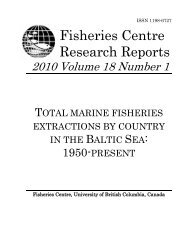Trends in GlobAl MArine Fisheries - Sea Around Us Project
Trends in GlobAl MArine Fisheries - Sea Around Us Project
Trends in GlobAl MArine Fisheries - Sea Around Us Project
You also want an ePaper? Increase the reach of your titles
YUMPU automatically turns print PDFs into web optimized ePapers that Google loves.
72<br />
The Stock-Catch Status Plots for the North <strong>Sea</strong><br />
LME, based on the first analysis of an LME<br />
us<strong>in</strong>g such plots (Froese and Pauly 2003), <strong>in</strong>dicate<br />
that the number of collapsed and overexploited<br />
stocks have been <strong>in</strong>creas<strong>in</strong>g, account<strong>in</strong>g for close<br />
to 80 percent of all commercially exploited stocks<br />
<strong>in</strong> the North <strong>Sea</strong> (Figure 11, top). A majority of<br />
the reported land<strong>in</strong>gs biomass, particularly <strong>in</strong><br />
Number of stocks by status (%)<br />
Catch by stock status (%)<br />
Develop<strong>in</strong>g Fully exploited Over-exploited<br />
(n=4539)<br />
Collapsed<br />
(n=4539)<br />
Figure 11: Stock-Catch Status Plots for the North <strong>Sea</strong> LME,<br />
show<strong>in</strong>g the proportion of develop<strong>in</strong>g (green), fully exploited<br />
(yellow), overexploited (orange) and collapsed (purple) fisheries<br />
by number of stocks (top) and by catch biomass (bottom) from<br />
1950 to 2004.<br />
Note that (n), the number of ‘stocks’, i.e. <strong>in</strong>dividual land<strong>in</strong>gs<br />
time series, only <strong>in</strong>clude taxonomic entities at species, genus or<br />
family level, i.e. higher and pooled groups have been excluded<br />
(see Pauly et al. <strong>in</strong> press for def<strong>in</strong>itions).<br />
recent years, is supplied by overexploited stocks<br />
(Figure 11, bottom).<br />
The Stock-Catch Status Plots for the Baltic <strong>Sea</strong><br />
LME <strong>in</strong>dicate that over 60 percent of the fished<br />
stocks <strong>in</strong> the LME have collapsed (Figure 12,<br />
top), but that the majority of the catch is supplied<br />
by fully exploited stocks (Figure 12, bottom),<br />
likely due to the large European sprat catches.<br />
Number of stocks by status (%)<br />
Catch by stock status (%)<br />
Develop<strong>in</strong>g Fully exploited Over-exploited<br />
(n=2007)<br />
Collapsed<br />
(n=4539)<br />
(n=2007)<br />
Figure 12: Stock-Catch Status Plots for the Baltic <strong>Sea</strong> LME, show<strong>in</strong>g<br />
the proportion of develop<strong>in</strong>g (green), fully exploited (yellow),<br />
overexploited (orange) and collapsed (purple) fisheries by<br />
number of stocks (top) and by catch biomass (bottom) from 1950<br />
to 2004.<br />
Note that (n), the number of ‘stocks’, i.e. <strong>in</strong>dividual land<strong>in</strong>gs<br />
time series, only <strong>in</strong>clude taxonomic entities at species, genus or<br />
family level, i.e. higher and pooled groups have been excluded<br />
(see Pauly et al. <strong>in</strong> press for def<strong>in</strong>itions).<br />
FISH, SUSTAINABILITY AND DEVELOPMENT





![Nacion.com, San José, Costa Rica [Nacionales] - Sea Around Us ...](https://img.yumpu.com/26166123/1/190x245/nacioncom-san-josac-costa-rica-nacionales-sea-around-us-.jpg?quality=85)










